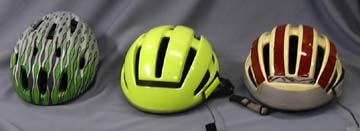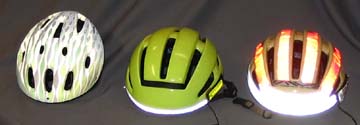Helmets.org
Bicycle Helmet Safety Institute
Consumer-funded, volunteer staff
| Helmets | Children | Promotions | Statistics | Search |
Reflective Materials on Bicycle Helmets
Summary: We believe that reflective materials on helmets can increase night time conspicuity, but tests conducted by CPSC failed to confirm that. Reflectors can never replace active lights.
BHSI has been a long-time supporter of the use of reflective materials on helmets to increase night time conspicuity.
CPSC Standard
In 1995 BHSI worked with 3M to organize a night-time demonstration for CPSC staff of various reflective tapes that could be used on helmets. We were asking CPSC to add a requirement for a retro-reflective surface area to make helmets more visible under night conditions. After that demonstration the agency undertook its own more scientific testing and determined that adding reflective surface did not aid motorists in recognizing a bicycle rider earlier. In fact their results showed that the reflective tape appeared to lengthen the time for recognition of a cyclist. It is possible that the reflective tape confused the driver about what they were approaching, since it would not immediately carry the signature of a cyclist or a helmet, but just appear as a bright something-or-other point ahead. So the bright spot would catch a driver's eye, but not necessarily identify the source. That would, of course, change if every helmet had similar reflective surfaces, and driver identification would be quicker. In any event, CPSC decided not to add a reflective requirement to their standard.Here is the standard we were proposing. The early drafts were based on a hot 3M material, but the reflectivity requirement had to be reduced when it developed that none of their competitors had a material that bright, and the standard could not bless one manufacturer's product.
Add tape?
Should you add tape to your helmet? Maybe. We do. But please read this page on stickers first for the ins and outs of putting sticky stuff on your helmet. The solvent in the adhesive can attack helmet shells and weaken them unless you are sure of the compatibility of shell and tape. The best tapes are not available in normal consumer channels, because they would be too expensive. The adhesives used by 3M for consumer-grade Scotchlite tape are apparently compatible with many helmet shells, but not necessarily all. Flashbrite has stickers made of 3M Scotchlite. 3M also has some really hot tape available in commercial channels and at some websites for marking tractor trailers and other purposes. Other manufacturers have similar products, but we don't know about their adhesives.Limitations
Reflective trim can't make you safe at night. At a minimum you need active lights and more. Any reflective surface on a helmet is high above the street level where car lights concentrate most of their beam, and if there is no light shining on the reflective surface to bounce back at the driver there is no advantage at all to reflectivity. In a side collision the angles may result in the tape reflecting toward the driver only at the last possible second as the cyclist enters the headlights, too late to avoid the crash. On a hilly road the headlights might be zooming into the sky if the car is coming over a hill or might be dropping down at the bottom of a depression, and never illuminate your tape. And as noted above, the driver may not realize that the bright spot ahead is a cyclist's helmet. We have a page on using active lights that discusses this more. You need active lights if you ride at night.Cameras and eyes do not show the same thing at night, so you have to see a demonstration in person and should not rely on anybody's video of how their product shows up in headlights. Looking at a reflective surface with light that is not close to the eye, or off-axis to the surface, is very different in person, and may show wide variations in the performance of the reflective material.
Reflective Helmets
The first company we found with reflective helmets was the Swedish manufacturer Headlight, with a line of helmets initially branded Solid, but now in Europe carrying the brands of distributors or retailers. In the US their products appear as Reflectek, manufactured by Kuji Sports. They have a number of adult and child models with outer shells in silver. They say all of their helmets meet the Swedish standard for reflectivity, even after ageing. Headlight technology is available in several models, certified to either European standards for the Euro market or CPSC for the US market. They have two grades of reflective shells, so the whole helmet is reflective, using the silver color that normally produces the best reflective performance. They apply graphics on top of that.In 2005 Kuji Sports introduced on the US market three bike helmets branded as Reflectek, one fully covered by a reflective shell, another with a partially reflective shell and a third with inmolded construction and partial reflectivity. Kuji no longer makes Reflectek helmets. The color of the fully reflective Reflectek was a dull silver, and it looked like a normal helmet in normal light. Here are photos of that Reflectek and two other helmets with reflective tape on them. The Reflectek is on the left, a neon yellow helmet with reflective rim tape in the middle, and a white helmet almost covered with reflective tape on the right.
 Below
are the three helmets lit as you might see them from a car.
Below
are the three helmets lit as you might see them from a car.  Although the tape is "hotter," the reflective material on the Reflectek covered the entire
helmet. Rather than providing just a point of light, the Reflectek provided the image of a helmet, giving the car driver
more of a clue as to what it is. For that reason we thought the fully reflective Reflectek is probably less likely to
disappear in the urban light clutter of a city street, although the intensity of its reflective surface was less than we
would ideally want. The partially reflective Reflectek models would not have the same advantage, and the hotter tape
would probably be better. But since there are few reflective helmets out there, a driver may not recognize that what they
are seeing is a helmet with a bicycle rider under it.
Although the tape is "hotter," the reflective material on the Reflectek covered the entire
helmet. Rather than providing just a point of light, the Reflectek provided the image of a helmet, giving the car driver
more of a clue as to what it is. For that reason we thought the fully reflective Reflectek is probably less likely to
disappear in the urban light clutter of a city street, although the intensity of its reflective surface was less than we
would ideally want. The partially reflective Reflectek models would not have the same advantage, and the hotter tape
would probably be better. But since there are few reflective helmets out there, a driver may not recognize that what they
are seeing is a helmet with a bicycle rider under it.We bought our sample of the Reflectek at Wal-Mart for $17.42. It had CPSC certification, of course. The warning label said "This helmet is not intended to promote night riding." Wal-Mart also had the partially reflective model, hanging on the same peg.